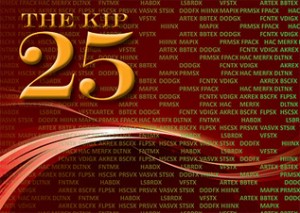 For several years now, the Kiplinger Personal Finance magazine has put together a selection of mutual fund recommendations it calls the “Kiplinger 25.” This is a portfolio of 25 no-load funds, in five different categories, that it considers to be of top quality.
For several years now, the Kiplinger Personal Finance magazine has put together a selection of mutual fund recommendations it calls the “Kiplinger 25.” This is a portfolio of 25 no-load funds, in five different categories, that it considers to be of top quality.
This portfolio, which also appears on the Kiplinger.com website, is fairly static, funds are infrequently added or dropped from one year to the next, and usually the changes are minimal.
It is fairly common for the financial media, websites, personal finance magazines, and newsletters to periodically offer up selections of mutual funds, which they consider as the cream of the crop.
The question readers have to ask themselves is what’s the depth and breadth of the qualitative and quantitative research that supports classifying these funds as worthy investment opportunities. Generally, my reaction has always been to check out, both as a group and individually, such mutual funds through Morningstar.
With regard to Morningstar, I’m going to hit the pause bottom here to give you some worthwhile guidance for evaluating mutual funds. But, first this reminder: While I use its services, I have no connection to or affiliation with Morningstar. Objectively speaking, I feel comfortable recommending its mutual fund investment research as unmatched in the industry.
In this regard, a comprehensive explanation of two unique Morningstar mutual fund evaluative tools – its Gold Analyst-Rating and related Fund Analysis – is available in the Schoolhouse Library’s educational booklet, Morningstar’s One-Page Wonder.
Back to the Kiplinger 25. There’s little doubt that individual investors tend to buy investments that catch their attention. The annual outing of the Kiplinger 25 mutual funds certainly has this effect. Kiplinger’s periodicals and website have a huge audience, most likely numbering in the millions. It is this circumstance, and many others like this, that prompts me to take out my mutual fund investing toolbox and put the aforementioned Morningstar evaluative tools to work.
Let’s take a look at the big picture, i.e., the portfolio as a whole. I think that the lack of index mutual funds in the Kiplinger 25 portfolio is a serious omission. Four broad-market, passively-managed funds – one each for domestic and foreign stock and bond categories – should make the cut for a 25-fund portfolio of top-rated selections.
Generally, only about one-third of the Kiplinger 25 mutual funds get Morningstar’s highest Gold Analyst-Rating. While there’s room for differences of opinion on fund ratings from differing sources, the aforementioned rating gap differential is hard to justify. I’m not implying here that Morningstar is infallible. However, its almost 30-year track record with mutual fund investment research has arguably set a very high level of excellence. The lack of a reasonable correlation between Kiplinger’s and Morningstar’s top-rated funds is suspect.
Lastly, and here I admit to being a tough grader, several Kiplinger selections always seem to get “Incompletes.” For example, funds that have track records in the range of 1 to 3 years are far below the 10-year standard that many investment professionals consider necessary as a reasonable basis for judging performance. What I call “start-ups,”may become great funds, but there are numerous highly rated “veteran funds” that are better alternatives than these relatively untested newcomers.
The lesson to be learned here is not to let headlines, or any sort of implied expertise, influence your buying individual mutual funds. Simply stated, the investment process is all about figuring out how to buy quality funds to hold for the long run. Morningstar’s evaluative criteria can help you do that.
Richard Loth is the founder and publisher of the Fund Investor’s Schoolhouse, a mutual fund investing educational platform for individual investors.

Pingback: [ kiplinger 25 best mutual funds 2014 ] Best Web Pages | (NetizenOpinion)
Pingback: Claire's Corner: The Beginning Investor's Edition